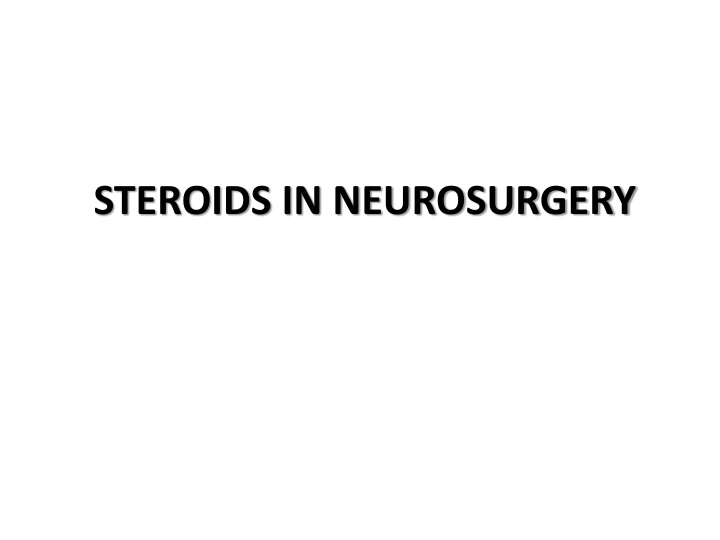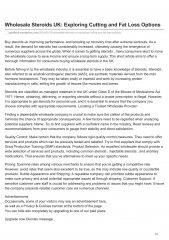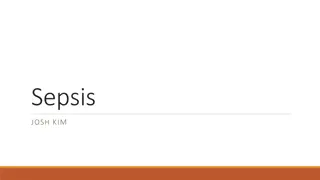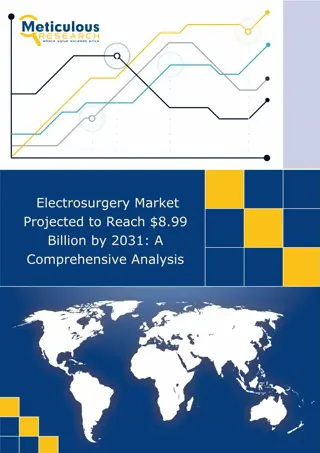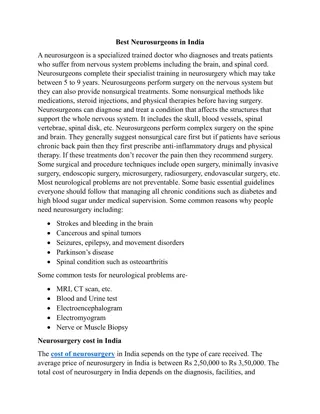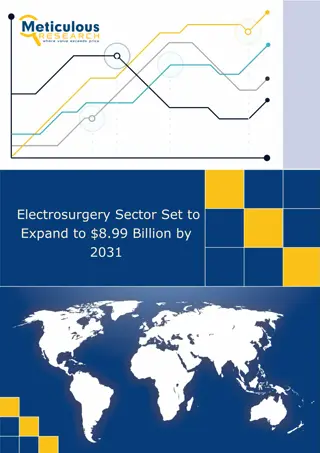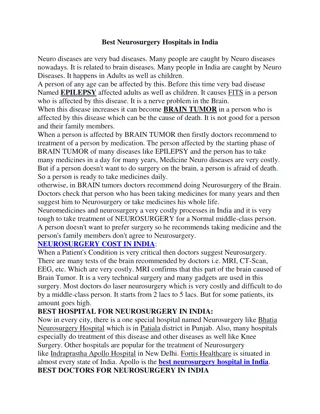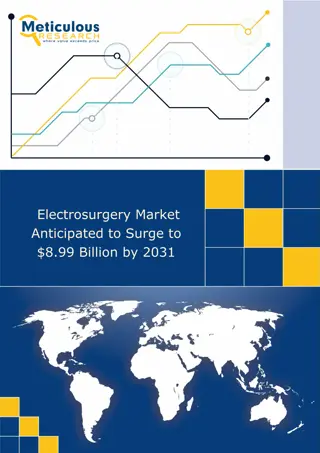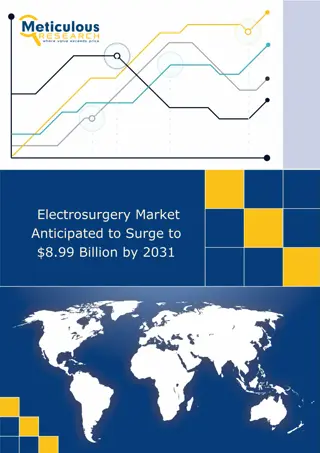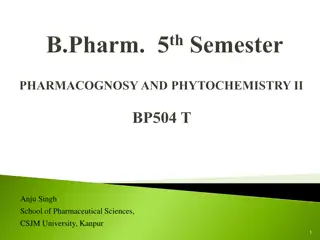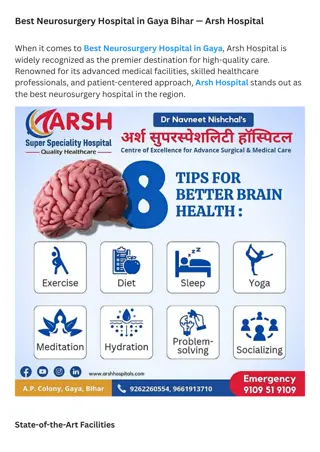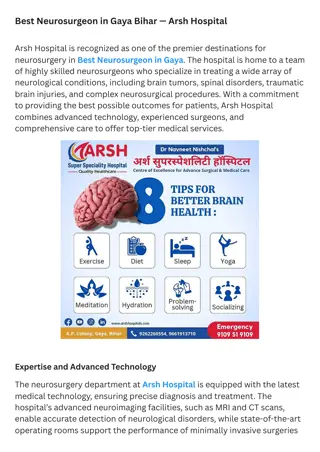STEROIDS IN NEUROSURGERY
Steroids have played a crucial role in the field of neurosurgery since their discovery in the mid-19th century. From the history of adrenal glands to the synthesis of different hormones, steroids have been instrumental in various medical conditions, including neurosurgical interventions. Understanding the basal secretions, preparations, and pharmacological actions of steroids is essential for healthcare professionals involved in neurosurgery. This comprehensive overview covers the key aspects of steroids' role in neurosurgery, from historical milestones to their current pharmacological actions and clinical applications.
Download Presentation

Please find below an Image/Link to download the presentation.
The content on the website is provided AS IS for your information and personal use only. It may not be sold, licensed, or shared on other websites without obtaining consent from the author.If you encounter any issues during the download, it is possible that the publisher has removed the file from their server.
You are allowed to download the files provided on this website for personal or commercial use, subject to the condition that they are used lawfully. All files are the property of their respective owners.
The content on the website is provided AS IS for your information and personal use only. It may not be sold, licensed, or shared on other websites without obtaining consent from the author.
E N D
Presentation Transcript
History 1855 Addison's disease 1856 Adrenal glands essential for life 1930 Cortex > medulla 1932 Cushing s syndrome 1949 Hench et al (Steroids in rheumatoid arthritis) 1952 Aldosterone
Synthesis Stimuli Part Principal product Angiotensin II Zona glomerulosa Zona fasiculata & reticularis Aldosterone ACTH Cortisol Adrenal androgens Sympathetic nervous system Adrenaline & Nor-adrenaline Medulla
Basal secretions Group Hormone Daily secretions 5 30 mg 2 5 mg 5 150 g Trace Glucocorticoids Cortisol Corticosterone Mineralocorticoids Aldosterone 11- deoxycorticosterone Sex Hormones Androgen Progestogen Oestrogen DHEA Progesterone Oestradiol 15 30 mg 0.4 0.8 mg Trace From Essential of Pharmacotherapeutics, ed. FSK Barar. P.351
Preparations Drug Anti-inflam. Salt retaining Topical Cortisol 1 1.0 0.8 0.8 0.3 0 1 0 0 4 5 Cortisone 0.8 4 5 5 Prednisone Prednisolone Methylpredni- solone Intermediate acting Triamcinolone 5 0 0 0 5 - 7 Paramethasone 10 15 Fluprednisolone
Preparations Anti-inflam. Drug Salt retaining Topical Long acting Betamethasone 25-40 30 0 0 10 10 Dexamethasone Mineralocorticoids Fludrocortisone 10 0 250 20 10 0 DOCA
Pharmacological Actions Direct (Intended) Actions Anti-inflammatory Anti-allergy Anti-immunity Permissive Actions Lipolytic effects Effect on bp Effect on bronchial muscles (e.g.,sympathomimetic amine)
Pharmacological Actions For most clinical purposes, synthetic glucocorticoids are used because they have a higher affinity for the receptor, are less activated and have little or no salt-retaining properties. Hydrocortisone used for: orally for replacement therapy, i.v. for shock and asthma, topically for eczema (ointment) and enemas (ulcerative colitis). Prednisolone the most widely used drug given orally in inflammation and allergic diseases.
Pharmacological Actions Dexamethasone: very potent, w/o salt- retaining properties; thus, very useful for high- dose therapies (e.g., cerebral edemas). Beclometasone, diproprionate, budesonide: more active when applied topically Triamcinolone: local joint inflammation (intra- articular inj.).
Actions:Anti-inflammatory Recruitment of WBC and monocyte- macrophage into affected area & of chemotactic substances Lipocortin elaboration ELAM1 and ICAM-1 in endothelial cells TNF from phagocytic cells IL1 from monocyte-macrophage Formation of Plasminogen Activator Action of MIF and fibroblastic activity Expression of COX II
Pharmacological Actions 8. Stomach 1. Carbohydrate 9. Blood 2. Protein 10. Anti-inflammatory 3. Lipid 11. Immunosuppressant 4. Electrolyte and H2O 12. Respiratory system 5. CVS 13. Growth and Cell Division 6. Skeletal Muscle 14. Calcium metabolism 7. CNS
Actions:Electrolyte and water balance Aldosterone is more important Act on DT and CD of kidney Na+ reabsorption Urinary excretion of K+ and H+ Addison s disease ?? Na+ loss Shrinkage of ECF Cellular hydration Hypodynamic state of CVS Circulatory collapse, renal failure, death
Actions:CNS Direct: Mood Behaviour Brain excitability Indirect: maintain BBB, circulation and electrolyte balance ICP (pseudotumor cerebri) - Rare
Role in traumatic spine and head injuries
Pathophysiology of Spinal Cord injury Primary mechanisms Initial crush, shear impingement of cord with the inciting trauma. Secondary mechanisms Vascular insults/insufficiency Edema Cell toxicity Apoptosis
Secondary Mechanisms Electrolytes Calcium release Cell toxicity Glutamate release, arachidonic acid metabolites, free radical generation Apoptosis Programmed cell death Vascular Dysautoregulation, hypotension, neurogenic shock
Secondary mechanisms Numerous mediators of spinal cord damage have been identified experimentally. The hope is that through simple pharmacologic interventions, the secondary damage can be limited, or even potentially reversed. Unfortunately very little clinical progress has been made to date.
Steroids Several studies have reported success with high dose steroid infusions, limiting progression of spinal cord damage in trauma. NASCIS II and III (NEJM 1990, JAMA 1997) Two highly publicized studies demonstrating small but clinically significant improvement with neurologic recovery following administration of high dose methyl- prednisolone NASCIS II placebo controlled NASCIS III dose varied. Not placebo controlled
NASCIS II(National acute spinal cord injury study) Steroid bolus 30mg/kg over 15min in 1st hour, then 5.4mg/kg/hr for 23 hours An average 70Kg patient would receive 23 GRAMS of steroid over 24 hours NASCIS II was in fact a negative study. Only on post hoc sub group analysis did steroid yield a benefit Only patients who received steroid in the first 8 hours post injury demonstrated a benefit What degree of benefit however?
NASCIS II Unfortunately, the degree of statistically significant benefit has no clinical relevance Motor score improvements were 17 .2 and 12.0 for steroid and placebo groups respectively (out of a total possible score of 70), which gives a difference of 5.2. A difference of 5.2 simply put could be gained if a patient regained the ability to shrug his shoulders.
NASCIS III MPSS 24 HR GROUP MPSS 48 HR GROUP TIRILAZAD GROUP 5.4 Mg/Kg/Hr. X 24 Hr. 5.4Mg/Kg/Hr. X 48Hr 2.5 Mg/Kg Bolus 6Hrly. X 48Hr Same as MPSS 24 Hr. Group Improved motor fnxn Improved motor fnxn
NASCIS III MPSS 24 Hr Group MPSS 48 GRP. Started within 3 to 8 Hrs. Started within 3 Hrs. Started in 3 Hrs. 3- 8 Hrs. Significant better Poor recove ry Significant better Pneumonia/Sepsis
Results Initiation of treatment within the first 3 hours is optimal The nonglucocorticoid tirilazad is as effective as 24-hour MP therapy; and If treatment is initiated more than 3 hours post-SCI, extension of the MP dosing regimen is indicated, from 24 hours to 48 hours.
Results However, in comparison with the 24-hour dosing regimen, significantly more glucocortioid-related immunosuppressive side effects were seen with more prolonged dosing In contrast, tirilazad showed no evidence of steroid-related side effects, suggesting that this nonglucocorticoid 21-aminosteroid would be safer for extension of dosing beyond the 48-hour limit used in NASCIS III.
Suggested Indications for the Use of MP in Acute SCI For acute non-penetrating SCI (<3 h after injury), MP should be given as per NASCIS II protocol (i.e. 24 hours of treatment) For acute non-penetrating SCI (>8 h after injury), MP should not be used For acute non-penetrating SCI (after 3 h, within 8 h), MP should be given as per NASCIS III protocol (i.e., 48 h of treatment) For acute penetrating SCI, MP is not recommended
Controversies Comparison of 24-h vs. 48-h MP dosing No placebo group for comparison Increased rates of wound infection/severe sepsis No significant benefit at 1 year follow up Benefits noticed in post hoc analysis only Fehlings MG. Editorial: recommendations regarding the use of methylprednisolone in acute spinal cord injury: making sense out of the controversy. Spine 26[Suppl 24): 56 57, 2001.
Conclusion Bracken et al Given the devastating impact of SCI and the evidence of a modest, beneficial effect of MP, clinicians should consciously consider using this drug despite the well- founded criticisms that have been directed against the NASCIS II and III trials. With great understanding of the biomolecular events contributing to the pathogenesis of SCI, it is hoped that other neuroprotective agents will enter into clinical practice in the next 5-10 years
Important Papers NASCIS II NEJM 1990 322:1405-11 NASCIS III JAMA 1997 277:1597-1604 Revisiting NASCIS II & III J. Trauma 1998 45:6 1088-93 Methylprednisolone for acute spinal injury . J. Neurosurg (Spine 1) 2000:93:1-7
CRASH Corticosteroid Randomisation After Significant Head Injury A large simple placebo controlled trial, among adults with head injury and impaired consciousness Studied the effects of a 48-hour infusion of corticosteroids on death and neurological disability
Aggregate mortality from 13 randomised trials of steroids in head injury 40% 39% DEAD 37% DEAD 35% 422 out of 1087 396 out of 1061 30% Steroid Control Alderson P, Roberts I. BMJ 1997;314:1855-9
Aim To determine reliably the effects of high dose corticosteroid infusion on: death and disability after head injury risk of infection and gastrointestinal bleeding Primary outcomes Death within 2 weeks Death or disability at 6 months
Results 10,008 adults with head injury and a Glasgow Coma Scale score of 14 or less, within 8 h of injury 48-h infusion of corticosteroid (methylprednisolone) or placebo. Data at 6 months were obtained for 9673 (96.7%) patients. .
Results The risk of death was higher in the corticosteroid group than in the placebo group (1248 [25.7%] vs 1075 [22.3%] deaths; relative risk 1.15, 95% CI 1.07-1.24; p=0.0001) There was no evidence that the effect of corticosteroids differed by injury severity or time since injury. These results lend support to earlier conclusion that corticosteroids should not be used routinely in the treatment of head injury
Discussion Landmark for head injury research Also a red flag warning clinical trials Planned to randomize 20,000 patients Powered to detect a drop in mortality from 15% to 13% (?? Only 2%) Document relatively small but important improvements in outcome
CRASH data safety monitoring board asked that the trial be stopped after 10,008 patients from 239 hospitals in 49 countries had been randomized
WHY ?? No evidence that MPSS improved survival Mortality was greater in the MPSS treated patients 1248 [25.7%] vs 1075 [22.3%] Relative risk 1.15, p=0.0001 Risk could not be attributed to injury
References Final results of MRC CRASH, a randomized placebo-controlled trial of intravenous corticosteroid in adults with head injury outcomes at 6 months. Lancet 365: 1957 1959, 2005 Alderson P, Roberts I: Corticosteroids for acute traumatic brain injury. Cochrane Database Syst. Rev 2:CD000196, 2000. CRASH (CORTICOSTEROID RANDOMIZATION AFTER SIGNIFICANT HEAD INJURY TRIAL): LANDMARK AND STORM WARNING.Neurosurgery 57:1300-1302, 2005
Brain tumors Pituitary adenoma Gliomas Meningiomas Brain edema Spinal pathologies Vascular
Glucocorticoid Replacement in Pituitary Surgery: Guidelines for Perioperative Assessment and Management The first decision regarding the perioperative use of glucocorticoid cover depends on the result of the preoperative screening test Abnormal ACTH 1 24 (Synacthen) test. dose regimen, using hydrocortisone, is 50 mg every 8 h on d 0, 25 mg every 8 h on d 1, and 25mg at 0800 h on d 2. alternative regimen, using dexamethasone 4mg at induction of anesthesia, 2 mg at 0800 h on d 1, and 0.5 mg at 0800 h on d 2. Dexamethasone has the advantage of a long half-life, which allows for single daily administration. Individuals with normal HPA axis function show a return to baseline cortisol secretion within 48 h of major surgery, providing that no complications have occurred* * Salem M, Tainish RE, Bromberg J, Loriaux DL, Chernow B 1994 Perioperative glucocorticoid coverage. A reassessment 42 years after emergence of a problem. Ann Surg 219:416 425
Pre-operative Normal ACTH 1 24 (Synacthen) test. If neurosurgeon is able to perform a selective adenomectomy no perioperative glucocorticoid cover be given There is good evidence that such an approach is safe in this patient group If selective adenomectomy is not possible and surgery is more extensive Glucocorticoid cover for 48 h and proceed as above. Otherwise, we recommend measuring 0800 h plasma cortisol on d 1 3 postoperatively. Again, the subsequent use of glucocorticoidreplacement depends on these results
Post-operative Many patients show a rapid increase in pituitary hormone secretion after pituitary adenomectomy Result of increased flow of hypothalamic releasing hormones through the hypothalamic-hypophysial portal system A patient with hypopituitarism may gain full functional recovery, providing that viable normal pituitary tissue remains in situ. Prolonged treatment with high doses of glucocorticoids postoperatively may result in adrenal suppression and mask those who spontaneously recover function.
Post-operative Provided there are no postoperative complications, glucocorticoid supplementation should be withdrawn, after 48 h Measurement of 0800 h plasma cortisol levels performed daily between d 3 and 5 postoperatively Daily clinical assessment of the patient, together with these cortisol results, will determine the subsequent use of glucocorticoid replacement therapy
ACTH-secreting adenomas Cushing s disease presents a special situation, with all patients requiring perioperative glucocorticoid cover. The presence of low plasma cortisol levels postoperatively implies a surgical cure Patients with low plasma cortisol levels after pituitary surgery for Cushing s disease require physiologic hydrocortisone replacement therapy with ongoing review of their HPA axis. The aim is to gradually withdraw the hydrocortisone as the ACTH suppression recovers.
ACTH-secreting adenomas Normal plasma cortisol levels postoperatively usually indicate ongoing autonomous ACTH secretion. The clinician must decide whether early repeat surgery is indicated or use an alternative modality of treatment, such as radiotherapy or adrenolytic therapy. Estimation of 24-h urinary free cortisol may help in this decision and may be performed while receiving physiological replacement with dexamethasone (0.5 0.75 mg daily). The CRH test and ACTH 1 24 test have also been used in this setting but, overall, seem to add little to the basal measurements of plasma and urinary free cortisol in predicting relapse.
